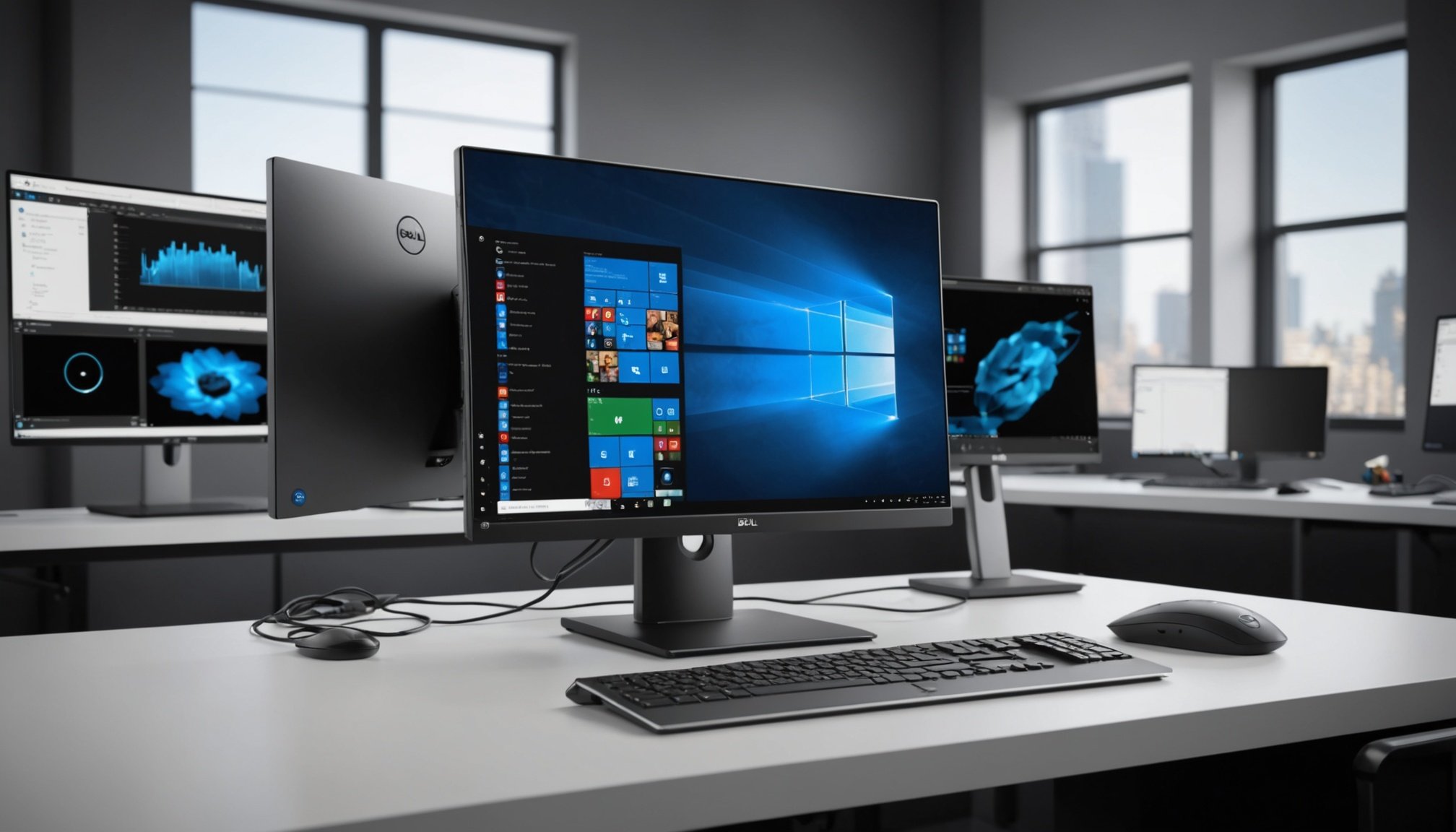Understanding Your Dell Precision 5750’s Hardware Capabilities
To fully leverage the hardware capabilities of the Dell Precision 5750, it is essential to understand the profound impact of its CPU and GPU specifications. The Dell Precision 5750 specs highlight that it typically houses Intel’s Core i7 or i9 processors, alongside powerful NVIDIA Quadro GPUs. These chips are designed to handle intensive tasks, essential for CAD and 3D rendering applications.
When considering RAM, it is crucial to account for the requirements for 3D rendering and CAD. A minimum of 16GB is recommended, although 32GB or more offers superior performance and multitasking abilities, reducing rendering times significantly.
Also to discover : Elevate Your Cooling Efficiency: Optimize Dual-GPU Performance with the Corsair Crystal Series 680X for Superior Gaming Experience
Another critical aspect is the choice between SSD and HDD to enhance your Dell Precision 5750 specs. SSDs offer quicker boot times and faster data access compared to traditional HDDs, which enhances overall performance significantly. For professionals handling complex graphics and data-heavy workloads, the importance of an SSD cannot be overstated.
In essence, optimizing for hardware capabilities ensures that your Dell Precision 5750 performs at its peak, allowing users to tackle demanding software efficiently while maintaining longer service life. Understanding these foundational components will lay the groundwork for further system enhancement and optimization.
Topic to read : Unlock Stunning 4K Video Editing: Essential Techniques to Supercharge Your HP Z2 Tower G5
Optimizing Software Settings for CAD and 3D Rendering
To unlock the full potential of your Dell Precision 5750, tuning software settings for CAD applications is paramount. By fine-tuning your settings, you can achieve smoother operations and faster rendering.
Recommended Settings for CAD Applications
For optimal performance, configure your CAD software to leverage the full capabilities of your processor and GPU. This may involve adjusting settings like graphics acceleration and precision levels to enhance processing speed and accuracy.
Optimal Graphics Driver Configurations
Keeping your graphics drivers up-to-date is crucial. Always use drivers recommended by the manufacturer to ensure compatibility and performance optimization. These drivers are tailored to work seamlessly with your system’s specific hardware, enhancing both speed and stability.
Adjusting Software Preferences for Performance
Within CAD applications, prioritise settings that boost performance. These include simplifying graphic detail levels and managing background processes. Consider disabling unnecessary software features that consume resources but do not contribute directly to your specific tasks.
By optimising these software settings, users can experience significantly improved performance, allowing their Dell Precision 5750 to handle even the most demanding CAD and 3D rendering tasks effortlessly.
Hardware Upgrades for Enhanced Performance
To achieve superior performance on your Dell Precision 5750, strategic hardware upgrades like enhancing RAM and installing a high-performance SSD can make a substantial difference.
Upgrading RAM
Increasing your RAM from the standard setup to 32GB or more enhances multitasking capabilities and improves software efficiency, especially for demanding 3D rendering and CAD tasks. Ensure that the RAM modules are compatible with your Dell Precision 5750’s motherboard. Always consult the hardware capabilities of your system to decide the optimal RAM configuration.
Installing a High-Performance SSD
Switching to a high-performance SSD from an HDD can dramatically decrease boot times and increase data access speeds. This upgrade is vital for professionals handling substantial datasets. SSDs offer improved durability and energy efficiency—key considerations for mobile workstations.
Enhancing GPU Capabilities
If you require higher graphical performance, consider upgrading your GPU. This is crucial for reducing rendering times and improving visual outputs in graphic-intensive tasks. Prior to upgrading, ensure the GPU is compatible with the existing Dell Precision 5750 specs and assess the cost-benefit ratio.
Each upgrade can significantly impact overall performance, allowing you to utilise your Dell Precision 5750 for more demanding applications without interruption.
Cooling Solutions for Sustained Performance
To maximise the performance capabilities of your Dell Precision 5750, adequate cooling solutions are crucial. High-performance tasks like CAD and 3D rendering can cause thermal management issues, leading to throttled speeds and reduced efficiency.
Recommended Cooling Pads and Internal Upgrades
- Cooling pads: These enhance airflow and reduce overall temperature. Opt for models that fit the laptop size and provide adjustable fan speeds.
- Internal upgrades: Upgrade internal fans or heatsinks with high-efficiency models, when possible, for better heat dissipation.
Monitoring Temperature During Intensive Tasks
Keep an eye on system temperatures during heavy workloads. Use trusted software tools to monitor CPU and GPU heat levels. Proactive thermal management can prevent hardware degradation and maintain optimal performance. Adjust cooling solutions to align with the system’s operational highs and lows, ensuring your Dell Precision 5750 remains responsive and reliable.
By investing in effective cooling solutions, you’ll extend the life of your hardware and preserve its ability to perform under pressure. Addressing these heat-related challenges is fundamental to achieving a stable and high-performing system environment.
Power Settings and Energy Efficiency
Adjusting power settings of your Dell Precision 5750 is essential to balance between peak performance and optimal energy efficiency. Maximising battery life, while handling intensive tasks, requires effective configuration.
Configuring Power Settings
To configure your power settings for a blend of performance and energy saving, consider customising the existing power plans. On Windows, access the Power Options panel and tailor settings under “Advanced Power Settings.” Prioritise processor state, where minimising the maximum state can help in conserving energy.
Insights on Battery Life for Intensive Tasks
Maintaining battery life during demanding activities, like 3D rendering, necessitates smart management. Disable features such as Bluetooth and reduce screen brightness. Use Battery Saver mode during light tasks to extend battery longevity.
Balancing Performance and Heat Generation
Effective thermal management ensures optimal performance without unnecessary heat generation. Tweak power settings to limit excess heat production, while still meeting performance needs. Implement cooling solutions like cooling pads to assist in temperature regulation.
By intertwining power settings adjustments with smart usage habits, you can preserve your Dell Precision 5750’s energy, maximize its efficiency, and ensure battery health during complex workloads.
Performance Benchmarks and Testing
Conducting performance benchmarks on your Dell Precision 5750 provides a practical view of its hardware capabilities and helps in identifying potential areas for improvement. Regular testing ensures you’re getting the most from Dell Precision 5750 specs.
How to Conduct Performance Benchmarks
Begin with dedicated software tools like Geekbench or Cinebench to measure CPU and GPU performance specifically. These tests offer insights into processing speed and efficiency, especially in resource-intensive tasks like 3D rendering. Ensure the benchmarking process aligns with your typical usage pattern for accurate results.
Analyzing Results and Making Adjustments
Post-benchmark, analyze the scores to evaluate your system’s strengths and weaknesses. For instance, if your GPU performance is lacking, consider reviewing your current hardware upgrades plan. Use these insights to tailor your software settings and optimise for better efficiency.
Common Benchmarks for 3D Rendering and CAD
Utilise benchmarks that simulate 3D rendering and CAD workloads, such as SPECviewperf, which assesses how effectively your setup handles these tasks. These benchmarks provide a realistic measure of your system’s capability, informing you whether additional adjustments in settings or power settings are necessary.
Community Insights and Shared Experiences
Understanding user experiences and leveraging peer insights can significantly enhance your journey with the Dell Precision 5750. Listening to community recommendations can provide practical solutions and alternative strategies to optimize your workstation.
Summary of User Feedback
The feedback from Dell Precision 5750 users often highlights the importance of modifying hardware and software settings to align with specific application needs. Users frequently emphasize upgrading RAM and SSDs to boost performance during intense workloads, like 3D rendering, which demands substantial hardware resources.
Recommended Additional Resources and Forums
Engaging with online forums and communities can further aid in customizing your Dell Precision 5750’s performance. Websites such as Reddit or specialized CAD forums offer real-world insights and troubleshooting tips. These platforms provide invaluable community recommendations, facilitating the sharing of effective optimization techniques.
Importance of Peer Insights
Peer insights play a crucial role in understanding the most efficient ways to exploit the hardware capabilities of the Dell Precision 5750. Shared experiences highlight innovative solutions to common challenges, and can guide you through the nuances of hardware upgrades and software configuration.
By participating in these communities, you gain access to collective wisdom, helping you maximise the potential of your workstation while avoiding common pitfalls.






